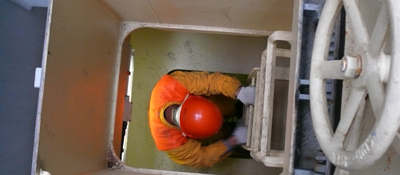Regionaldirektion Nord
Millerntorplatz 1
20359 Hamburg
Bereich Rente
Benefits
- Pension insurance: not just old-age pensions
- Overview: Kinds of pensions
- Reduced earning capacity pension
- Old-age pension
- Surviving dependents pensions
- Overview: Rehabilitation
- Medical measures
- Measures for vocational integration
- Supplementary assistance for integration
Pension insurance: not just old-age pensions
The first thought in the context of „pension insurance“ is the old-age pension, paid after well deserved retirement. This is in fact by far the most important item amongst the benefits of the statutory pension insurance, but not the only one. There are also reduced earning capacity pensions and widow’s pensions as well as therapeutic treatments and other benefits aimed at maintaining and restoring earning capacity (rehabilitation).
Overview: kinds of pensions
The following kinds of pensions are paid:
Pension are only paid on application. The date of application is important for the start of payments.
Reduced earning capacity pension
In the reduced earning capacity pension a difference is made between the partial reduction and the full reduction of earning capacity. A pension due to partial reduction of earning capacity (partial reduced earning capacity pension) is paid to members who are permanently unable to do more than six hours of paid work a day because of ill health or disability. A pension due to full reduction of earning capacity (full reduced earning capacity pension) may be paid to members who are permanently unable to do more than three hours of paid work a day.
Reduced earning capacity pensions are paid to members until they reach the standard minimum pensionable age, if they have:
- a fully or partially reduced earning capacity,
- paid compulsory contributions for at least three years during the last five years before suffering the reduction of earning capacity, and
- completed the general qualifying period.
After the standard minimum pensionable age is reached, the standard old-age pension is paid.
If a recovery from the illness or disability causing the reduction of earning capacity can be expected, the reduced earning capacity pension may be paid temporarily.
The amount of pension depends on the amount of supplementary income. The partial reduced earning capacity pension can be paid in full or 50 per cent of it, the full reduced earning capacity pension in full or 75, 50 or 25 per cent of it. The limit for supplementary income is calculated individually.

Old-age pension
A standard old-age pension is paid to persons having reached the minimum pensionable age and having completed the 5-year general qualifying period.
The standard minimum pensionable age is 65 years for people born before 1 January 1947 and rises in steps for people born in the years 1947 to 1963. It is 67 for people born in 1964 or later.
The standard old-age pension can already be claimed from the age of 63. However, this results in pension deductions corresponding to the duration of payment prior to the relevant minimum pensionable age.
Members of 65 years age may claim the standard old-age pension without deductions, if they have completed the 45-year qualifying period.
The minimum pensionable age is different for members recognised as being severely disabled and having completed the 35-year qualifying period at the start of the pension. It is 63 years for people born up to 1951 and rises in steps for people born in the following years. It is 65 for people born in 1964 or later. The pension can already be claimed up to 3 years prior to the relevant minimum pensionable age. However, this results in pension deductions corresponding to the duration of payment prior to the relevant minimum pensionable age.
Members born up to 1951 are also entitled to an old-age pension, if they are at the start of the pension occupationally disabled or unable to earn as defined in the law applicable on 31 January 2000.
Members born prior to 17 November 1950 und having been severely or occupationally disabled or unable to earn as defined in the law applicable on 31 December 2000 on 16 November 2000 and remaining so at the start of the pension may claim the old-age pension without deductions, if they have completed the 35-year qualifying period.
Members born prior to 1 January 1952 who are, when payments are due to begin, either unemployed or in partial retirement, may under certain conditions claim-with deductions-the old-age pension on account of unemployment or after partial retirement early. Members born prior to 31 December 1945 can claim the pension early from age 60. The minimum pensionable age rises in steps for members born in the following years 1946 to 1951.
Women born before 1952 who have reached the age of 60, completed the 15-year qualifying period and paid compulsory contributions for more than ten years from the age of 40 are entitled to an old-age pension for women. This pension is no longer available for members born after 1951. For women born from 1940 to 1951 the minimum pensionable age for such pension without deduction rises in steps up to 65.
If an old-age pension is claimed prior to the standard minimum pensionable age, allowances for supplementary income apply. If the additional income exceeds the allowance, a partial pension may be claimed instead of a full pension. When the standard minimum pensionable age is reached, the additional income is no longer limited.
Surviving dependents pension
The German pension insurance pays, under certain conditions, pensions on account of the member’s death. These pensions are the:
- widow’s and widower’s pension,
- orphan’s pension,
- child-raising pension.
Widow’s and widower’s pension
The widow’s and widower’s pension is intended to protect the surviving dependents against poverty and to maintain, as far as possible, their former living standard, if they have no or only short periods of own employment. There is a minimum- and a maximum widow’s pension.
Widows and widowers who are able to contribute to their own upkeep to a considerable degree are entitled to the minimum widow’s pension.
Widows and widowers who are not able to contribute to their own upkeep are entitled to the maximum widow’s pension.
The minimum or maximum widow’s or widower’s pension is paid under the following conditions:
The widow or widower must
- raise a child not yet of age,
- be at least 47 years old, or
- have a reduced earning capacity.
Own income of the widow or widower is partly subtracted from the widow’s or widower’s pension, with an allowance (for supplementary income) that increases annually.
Orphan’s pension
Orphans are entitled to an orphan’s pension after the death of their father or mother, if the deceased parent has completed the general qualifying period of five years. If one parent has died there is an entitlement to a half-orphan’s pension; if both parents have died to a full-orphan’s pension.
Entitlement to an orphan’s pension lasts until the orphan reaches the age of 18. Orphans who are in primary or secondary education or in vocational training or prevented to provide for their own upkeep due to disability, receive orphan’s pensions up to the age of 27.
Child-raising pension
Members of the pension insurance are entitled to a child-raising pension, if their divorce was granted after 30 June 1977 and the divorced spouse has died,
- they raise their own child or a child of the divorced spouse,
- they have not remarried, and
- they have completed the general qualifying period.
For further questions please contact the pension insurance fund Knappschaft-Bahn-See (Phone 0800 1000 48080 - in Germany free of charge).

Overview: Rehabilitation
Rehabilitation measures of the pension insurance are aimed to prevent the loss of earning capacity of a member due to illness, disability or an accident.
Rehabilitation measures of the statutory pension insurance comprise:
Medical measures
Medical measures are provided mainly to in-patients at special rehabilitation clinics. Subsistence and accommodation expenses are also covered by the pension insurance fund.
The medical measures comprise in particular:
- Treatment by doctors and other specialists
- Therapeutic remedies as well as kinesis-, speech- and occupational therapy, medicines and dressings
- Work therapy and tolerance-level testing
Measures for vocational integration
The measures for vocational integration are mainly provided by vocational training centres, vocational retraining centres and similar institutions for vocational rehabilitation.
- Support to maintain or obtain employment
- Preparation for employment
- Vocational adaptation and further training
- Motor vehicle assistance
- Payment for technical aids and for fitting out and maintenance of flats adapted to the needs of the disabled.
Supplementary assistance for integration
One of the most important measures for integration is the transitional allowance. It ensures an income for the member and his family during medical rehabilitation of the member.
The transitional allowance is variable, depending on the income of the member. For members without children it amounts to 68 per cent of the last net income from work, for members with at least one child 75 per cent. Social security contributions are paid by the pension insurance fund during the payment of a transitional allowance.
In addition to the transitional allowance there is other supplementary assistance for integration, amongst others:
- Rehabilitation sport (on prescription)
- Travel expenses
- Expenses for overheads, home help and child care.


